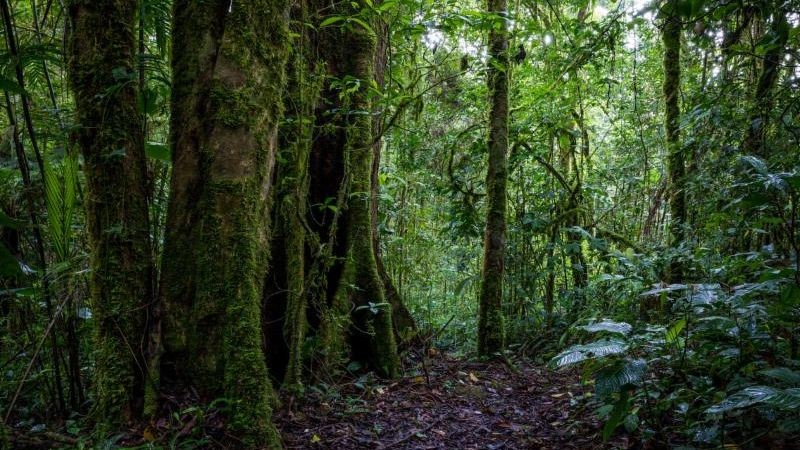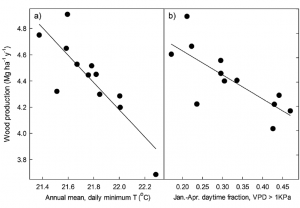Important Research at La Selva: How Tropical rain forest are affected by global climate change
By Dr. David Clark and Dr. Deborah Clark.
Tropical rain forests (TRF) contain a significant portion of the world’s plant and animal species and also store massive amounts of carbon. How these ecosystems are affected by global climate change will determine the survival of many thousands of species. In spite of the importance of understanding how TRF interact with climate, there have been very few studies on this topic. TRF are difficult to study. Tropical rain forests are generally in remote areas, are hot and extremely wet, and are often located in areas where scientific study is difficult due to local political or health conditions. The trees, the organisms that make up the biological and physical structure of the forest, can live several centuries, long beyond a researcher’s lifetime and even further beyond the period typically covered by research grants. In addition, the tropical rain forest that a researcher sees today may have been impacted by events that took place decades or even centuries ago, and discerning the legacies of climatic events or human impacts in real time is not easy.
The research described here successfully addressed many of these challenges. We called this project the CARBONO project, using the Spanish word for carbon. Our principal goal was to understand the sensitivity of tropical rain forests to changing climatic factors in order to predict the likely future for these forests. We worked in the Republic of Costa Rica, a remarkably welcoming and safe place to set up the long-term research required to study the growth and survival of the hundreds of tree species that makes up a tropical rain forest. In an undisturbed lowland rain forest, we set up a network of 18 study plots strategically sited across a large natural landscape. Every year from 1997-2019 we intensively measured many key aspects of the forest’s carbon use and carbon storage.
This research was funded by a National Science Foundation (NSF) program that specifically supports long-term research. Maintaining research like this over multiple decades in a tropical country is relatively expensive. By training local residents to take all of the field measurements and work with us as long-term project participants, we ensured the consistency of the field data and also lowered project costs. NSF emphasizes that the results of NSF-funded research must be made freely and publicly available. We are proud to have been leaders among tropical forest scientists in making the project’s data, and the associated information necessary to understand and use these data, freely available for downloading from the internet.
We discovered that the TRF we studied is tightly linked to current weather conditions. Trees grow significantly less in years with warmer nights and in years with drier air during the dry season (Figure 1).
All major science academies and professional organizations worldwide agree that the earth is warming due to humans’ activities, including our production of greenhouse gases like CO2. Based on our research findings, it is clear that increasing temperatures, even as little as 2-4o F, will significantly reduce tree growth and increase death rates for the tree species currently living in this forest. The forest we studied may not disappear as the earth warms, but the species there will certainly change as the more temperature- and drought-sensitive species succumb.
To date, the CARBONO Project is the only research study in the world that monitored all major aspects of the above-ground carbon cycle over an entire TRF landscape annually for two decades. It was only because of this intensive approach that we were able to detect and measure the high degree of linkage between local weather and the forest’s productivity. We and our colleagues have communicated the project’s findings to the public in more than a hundred publications over the life of the project.
We are in a period of unprecedented rapid change for tropical rain forests. Deforestation, resource extraction and global climate change are creating a perfect storm of assaults on these complex ecosystems. The CARBONO project has created and made publicly available the most complete description ever attempted for an intact TRF forest landscape. These data will for the foreseeable future be a baseline against which future tropical rain forests will be compared.
Figure 1. Wood production in a Tropical Rain Forest in Costa Rica in relation to temperature and intensity of the dry season. Wood production decreases as temperature and dry season intensity increase.


